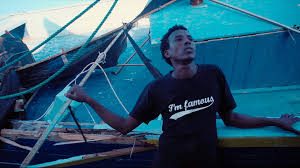
A storm suddenly passes as a group of migrants attempts to enter Europe by boat. One man goes overboard, separating from his family and drowns. In a purgatory like experience the soul of this man remains on Earth as a ghost and he starts shadowing the lives of countless other migrants who made it to Europe alive . And so begins “Those Who Feel the Fire Burning” , filmmaker Morgan Knibbe’s first feature length documentary. In this 2015 film, the Dutch director stunningly captures the hopeless experience that migrants face after they’ve crossed the border. “Those Who Feel the Fire Burning” specifically focuses on the lives of individuals from North Africa and the Middle East who have migrated to Europe. From the perspective of the drowned migrant’s ghost , Knibbe emphasizes the day to day difficulties migrants face in a foreign company. He is especially effective in capturing these experiences with his unsteady cinematography. The irregularity and shakiness of this filming style reflects the instability of these migrants lives.
Interviews with Knibbe reveal that, as I initially suspected, his the objective was to bring light to the collective migrant perspective. As a story teller, it’s clear that the he wanted to bring awareness to certain struggles, in a unique way. As a creative filmmaker Knibbe had another objective. He says that he “wanted to create hell on earth, or some sort of state in between heaven and hell, limbo or the purgatory. To do that [he] wanted to lift the images out of the realism and create a feeling of a huge void in sound design… The idea was to create a perspective for the audience as if they were experiencing it themselves.” At all of these thing, I believe Knibbe succeeded.
The intended audience could really be anyone but specifically those who didn’t already know the depth of the experiences that migrants face after that cross the border. As a part of that intended audience, I was moved by the film and felt like I was considering experiences and trauma that migrants face that I had never thought about before. “Those Who Feel the Fire Burning” may not be well known but by those who watched it, it was incredibly well received. The New York times applauded Knibbe for his abstract vision saying “the immersive style is always fascinating.. it also seems uneasily suited to the material.”. The La Times praised director for thinking out of the box: “The refugee experience has been documented in many a nonfiction film, but seldom as unconventionally as in Morgan Knibbe’s affectingly poetic first feature…Knibbe’s heavily stylized approach proves as potent as it is timely.” At the Netherlands Film Festival in 2017 , the film won two Golden Calf is the awards for best long documentary and sound design.
As much as I enjoyed the film, I made sure to think critically about it as well. For example, the informal structure of the film was one of my favorite parts about it but it may have prevented a portion of the audience from receiving it well or seeing the message. The unconventionality of the cinematography and directing could potentially prevent people from focusing on the context. The film didn’t consist of formal interviews and clean cut scenes like many documentaries. It was raw and up close and very shaky as well as confusing and disorienting at times. Not to mention, a formal plot is almost nonexistent as the film is a collage of many disconnected experiences .One Netflix user left a review saying that the film had “terrible writing, terrible directing, and terrible story telling.” Although I don’t agree with this comment at all, I can see it’s validity . However, where they equated the lack of structure with terrible filming, I appreciated the lack of structure as an excellent reflection of the context of the film.
Another criticism I had was that the film only focused on negative experiences . The negativity wasn’t forced and it certainly didn’t need to be fabricated but it was overwhelming. In this was the film may be perceived as a one-dimensional work that shows migrants as victim and exposed them at their most vulnerable moments. However, I think this was an intentional and effective choice. As a part of the audience I thought It was impactful to see the candid reality of these migrants’ horrible experiences. There where many instances when I had to stop the film because the scenes were so disturbing. As dramatic and as negative as these parts may have been , I think that this is where Knibbe succeeded most as filmmaker. It was these disturbing scenes that really moved me. The power of this film really comes from the way that Knibbe was able to ultimately captive the audience by making them uncomfortable.

Recent Comments